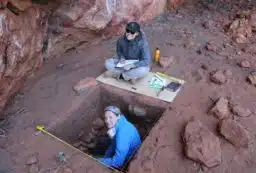Research by a Perth forensic scientist is helping to stem the flood of forgeries entering the international antiques market.
A Perth forensic scientist is employing lasers to help trace pottery back to the kiln site of its production, thus exposing ceramic forgeries, a multi-million dollar criminal business.
Emma Bartle from the Centre for Forensic Science at the University of Western Australia has developed a scientific method to authenticate porcelain, based on a technique known as elemental fingerprinting originally used to establish where gold came from. It employs lasers to vaporise a minute amount of material, which can then be analysed for the elements it contains, and how much of each is present. The process causes no visual damage to the ceramics.
“Over the past decade a multi-million dollar industry has grown up in South-East Asia, Cambodia and Laos to forge Chinese Ming and Japanese Imari porcelain,” Bartle says. “These modern fakes are so detailed and sophisticated that gone are the days whereby trained experts can authenticate pieces using visual examination alone.
“By analysing the porcelains’ chemical composition we can establish the geographical origins of an artefact and trace it back to the kiln site of its production in China or Japan. Each site has a different combination of trace elements, such as strontium and lanthanum, which is unique.”
The accepted conventional method of authentication at present uses emitted radiation to estimate the age of the porcelain; the idea being the older the object the less likely it is to be a fake. However, the process causes visible damage to the ceramics, decreasing both their cultural and monetary value. “Even worse, forgers have now caught up with the science and are artificially aging their imitations”, Emma remarks.
Elemental fingerprinting, pioneered by Prof John Watling for establishing the provenance of gold, is now routinely used in forensic applications. However, its adaptation and application to ceramics is new.
This unique research has sparked both local and international interest. Already museums, auction houses and private collectors have come forward to loan items from their collections for analysis. “We are working in collaboration with The Percival David Foundation of Chinese Art (London), Bonhams Auction House (London) and the Kyushu Ceramics Museum (Japan).”
“We have also analysed some of the ceramic artefacts recovered from Dutch shipwrecks along the Western Australian coastline, which were kindly loaned by the Western Australian Maritime Museum. Private collectors from the US and UK have also sent porcelain shards from their own collections for us to investigate,” says Emma.
Emma Bartle is one of 16 Fresh Scientists who are presenting their research to school students and the general public for the first time thanks to Fresh Science, a national program hosted by the Melbourne Museum and sponsored by the Federal and Victorian governments, New Scientist, The Australian and Quantum Communications Victoria. One of the Fresh Scientists will win a trip to the UK courtesy of the British Council to present his or her work to the Royal Institution.





 Fresh Science is on hold for 2022. We will be back in 2023.
Fresh Science is on hold for 2022. We will be back in 2023.